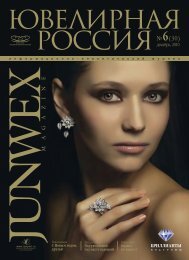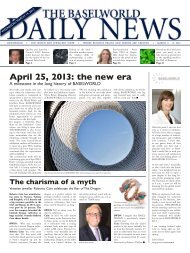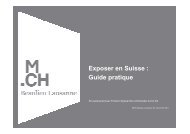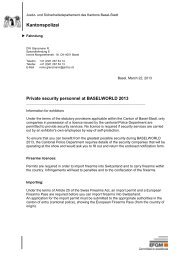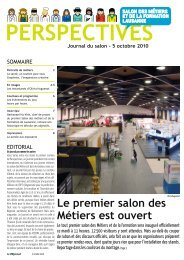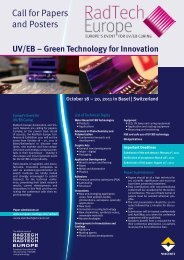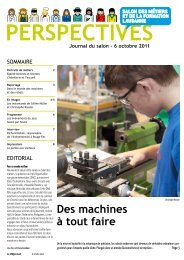WatchTime - August 2012
WatchTime - August 2012
WatchTime - August 2012
You also want an ePaper? Increase the reach of your titles
YUMPU automatically turns print PDFs into web optimized ePapers that Google loves.
PROFILE<br />
TAG Heuer’s Guy Sémon<br />
ter launching two new high-frequency<br />
chronographs within two months, including<br />
the first to achieve 1/1,000-second<br />
accuracy. Not Guy Sémon. His latest<br />
super-chronograph is called the<br />
Mikrogirder, and its design is a revolution<br />
in chronometry.<br />
To achieve something faster than<br />
1/1,000-second, Sémon had to abandon<br />
classic escapement design because,<br />
he says, traditional balance wheels and<br />
spiral hairsprings are not capable of oscillating<br />
reliably at frequencies above<br />
500 Hz. In a traditional escapement,<br />
the balance wheel oscillates back and<br />
forth somewhere between 270 and 320<br />
degrees in a horizontal position. While<br />
higher speeds and smaller amplitudes<br />
are possible (with smaller balance<br />
wheels and stiffer hairsprings), traditional<br />
escapements were never intended<br />
to operate at extremely high frequencies.<br />
Their physical limitations<br />
70 <strong>WatchTime</strong> <strong>August</strong> <strong>2012</strong><br />
The Mikrotimer<br />
Flying 1000<br />
achieves millisecond<br />
accuracy.<br />
meant a new design was needed. It was<br />
time to get out the proverbial clean<br />
sheet of paper.<br />
Sémon’s new design is inspired by<br />
the work of an 18th century French scientist,<br />
who, like Sémon, was a physicist<br />
and mathematician, not a watchmaker.<br />
During the 1740s, Jean le Rond<br />
d’Alembert published influential papers<br />
on the vibration of strings and<br />
wave equations, and his work still<br />
plays important roles in physics today.<br />
During his days as a university physics<br />
instructor, Sémon taught a class that<br />
included d’Alembert’s work.<br />
Sémon’s new d’Alembert-inspired<br />
regulator consists of three very small<br />
metal blades (TAG Heuer also calls<br />
them “girders” or “beams”) that can<br />
be induced to vibrate at high frequencies,<br />
and it represents a complete departure<br />
from the centuries-old balance<br />
wheel and spiral spring system.<br />
THE MIKROGIRDER’S<br />
FREQUENCY IS 1,000<br />
HZ, OR 7.2 MILLION<br />
VPH. TAG HEUER SAYS<br />
IT IS THE FASTEST<br />
MECHANICAL<br />
REGULATOR EVER<br />
CREATED AND<br />
TESTED.<br />
The Mikrogirder has an escape wheel<br />
that turns and makes contact with two<br />
teeth on an anchor, but that’s where any<br />
visual similarity to traditional escapements<br />
ends. The anchor excites the first<br />
of the three blades, called the excitating<br />
blade, which in turn excites the coupling<br />
blade, which excites the linear oscillator<br />
(also shaped like a blade). These three<br />
blades are mere millimeters long and<br />
small fractions of millimeters in diameter.<br />
The linear oscillator performs the<br />
same function as the hairspring in a traditional<br />
escapement, controlling the<br />
speed of the oscillation or vibration. In<br />
the prototypes we saw, the excitating<br />
blade is titanium, while the coupling<br />
blade and linear oscillator are steel.<br />
As Sémon explains his new system,<br />
the energy of the escape wheel’s rotation<br />
is converted into potential energy in the<br />
anchor and excitating blade. This sets up<br />
a vibration in the blades and linear oscillator.<br />
The escape wheel is like a finger<br />
plucking a guitar string (except the<br />
Mikrogirder does not generate an audible<br />
note). The Mikrogirder’s frequency is<br />
1,000 Hz, or 7.2 million vph. TAG<br />
Heuer says it is the fastest mechanical<br />
regulator ever created and tested. Explaining<br />
why he opted for 1,000 Hz, Sémon<br />
said, “I can cut 1,000 into two<br />
parts, and I can see for the first time the<br />
scale of 1/10,000s of a second. I can<br />
touch this scale for the first time in a mechanical<br />
system.”



